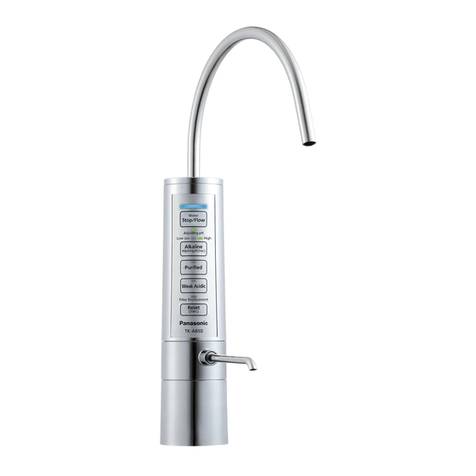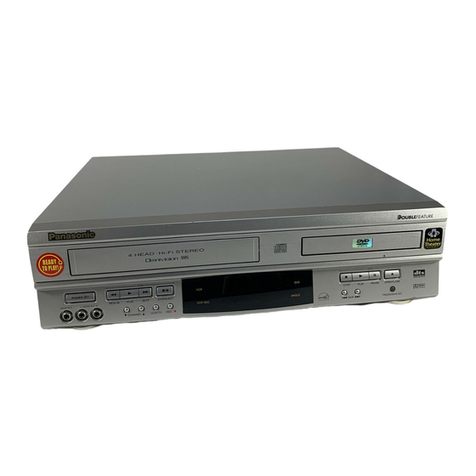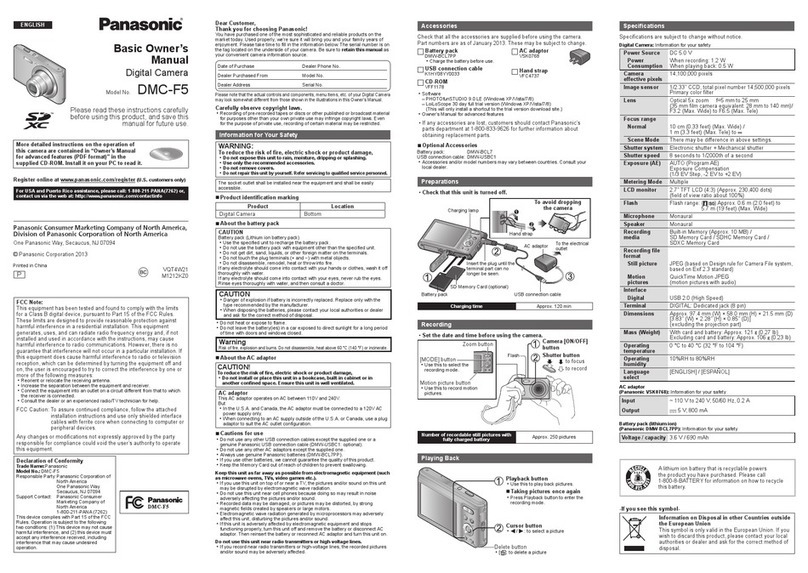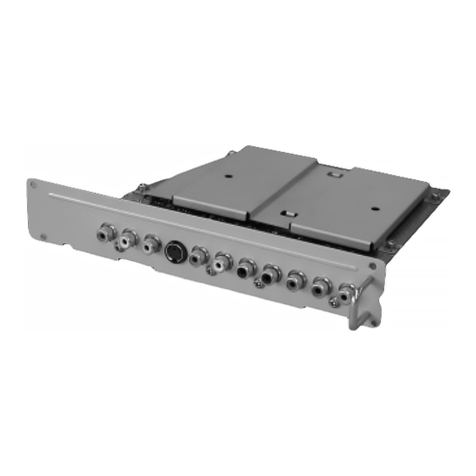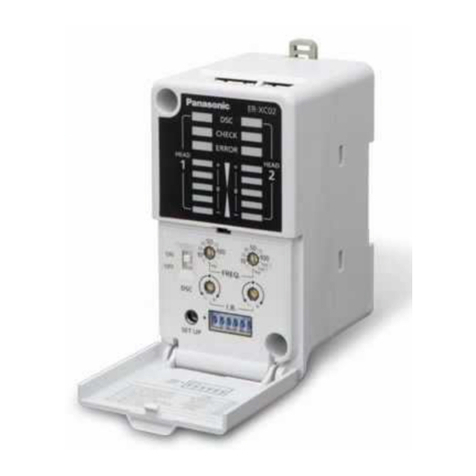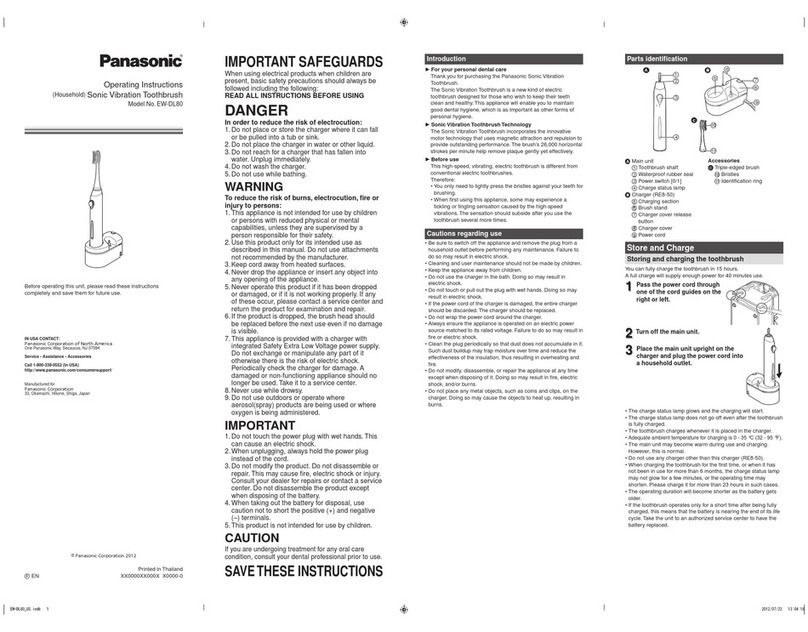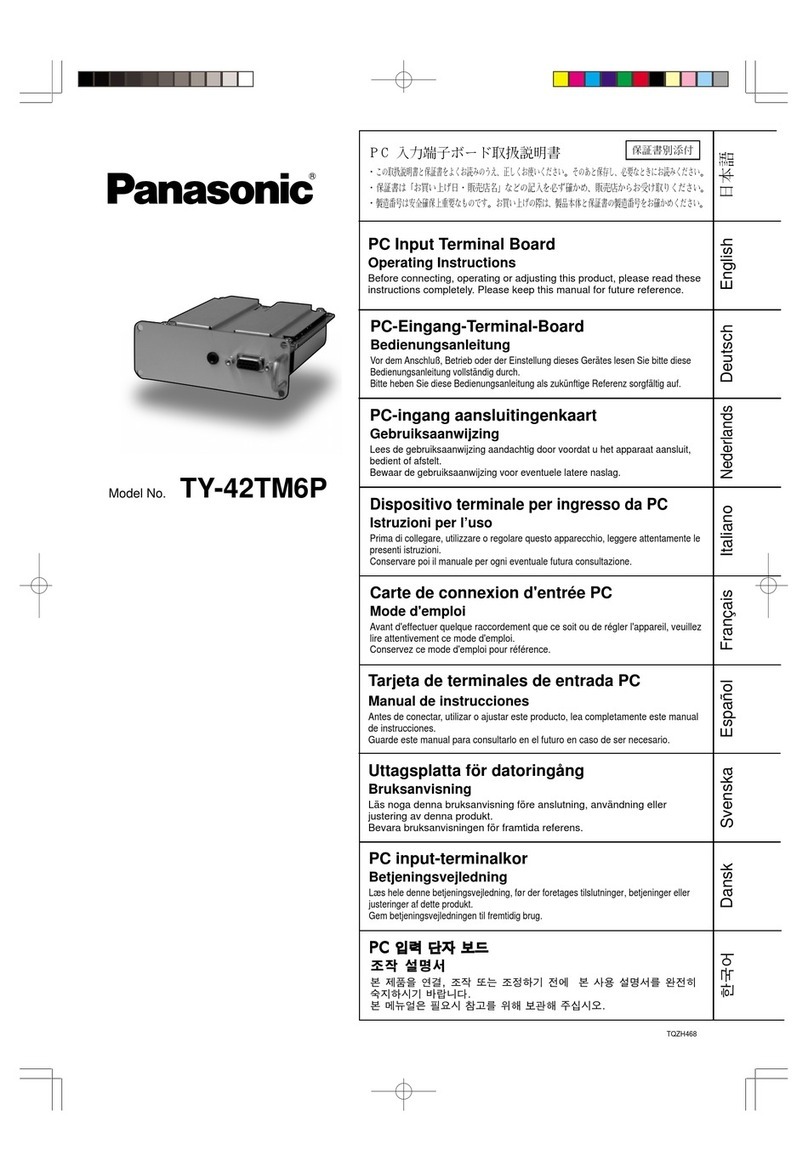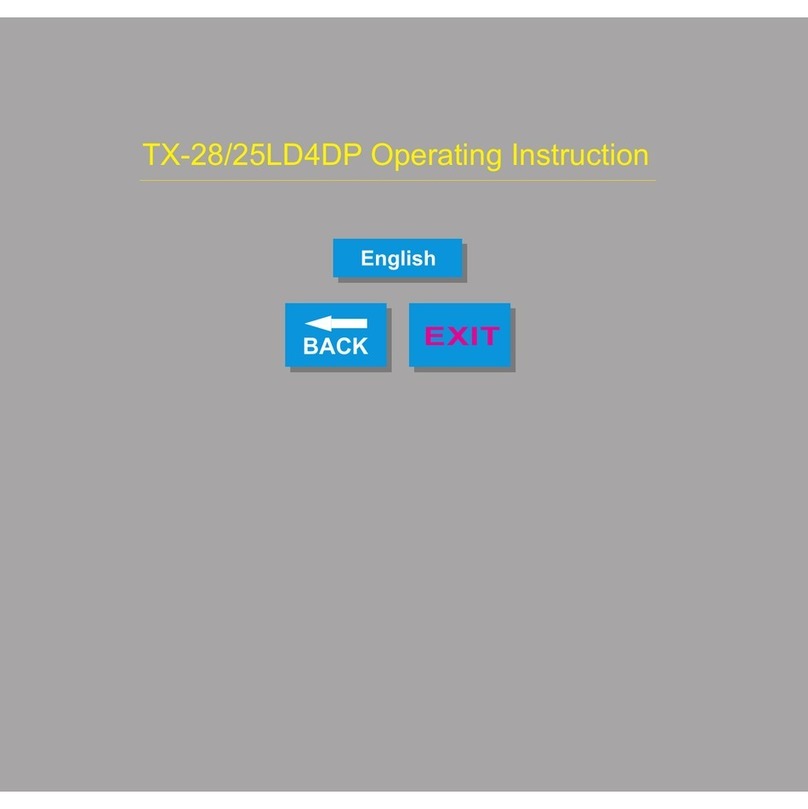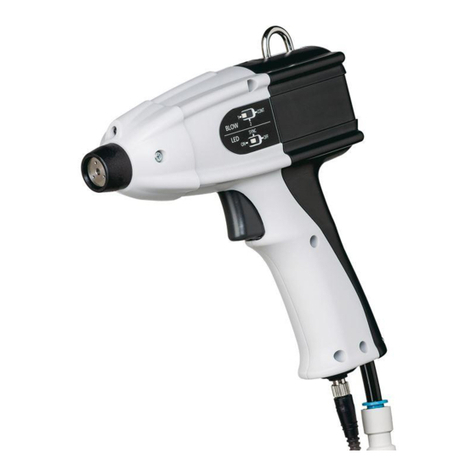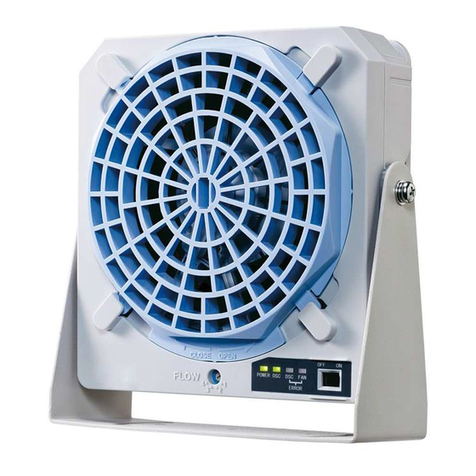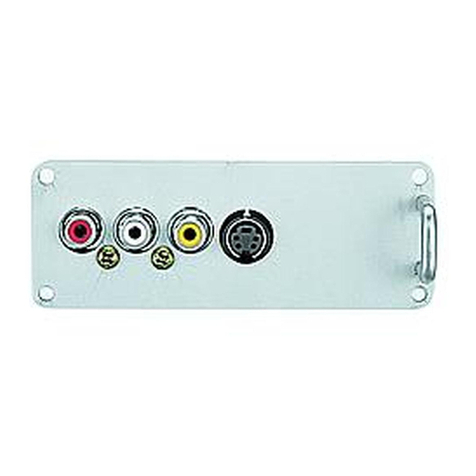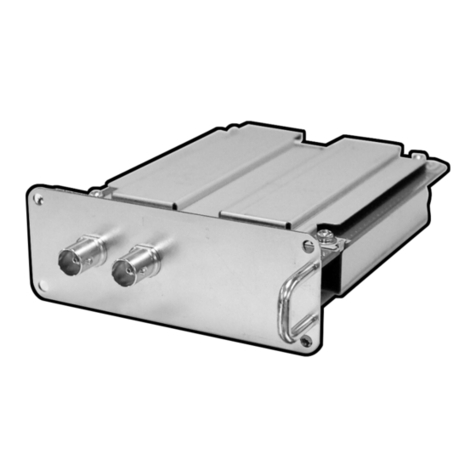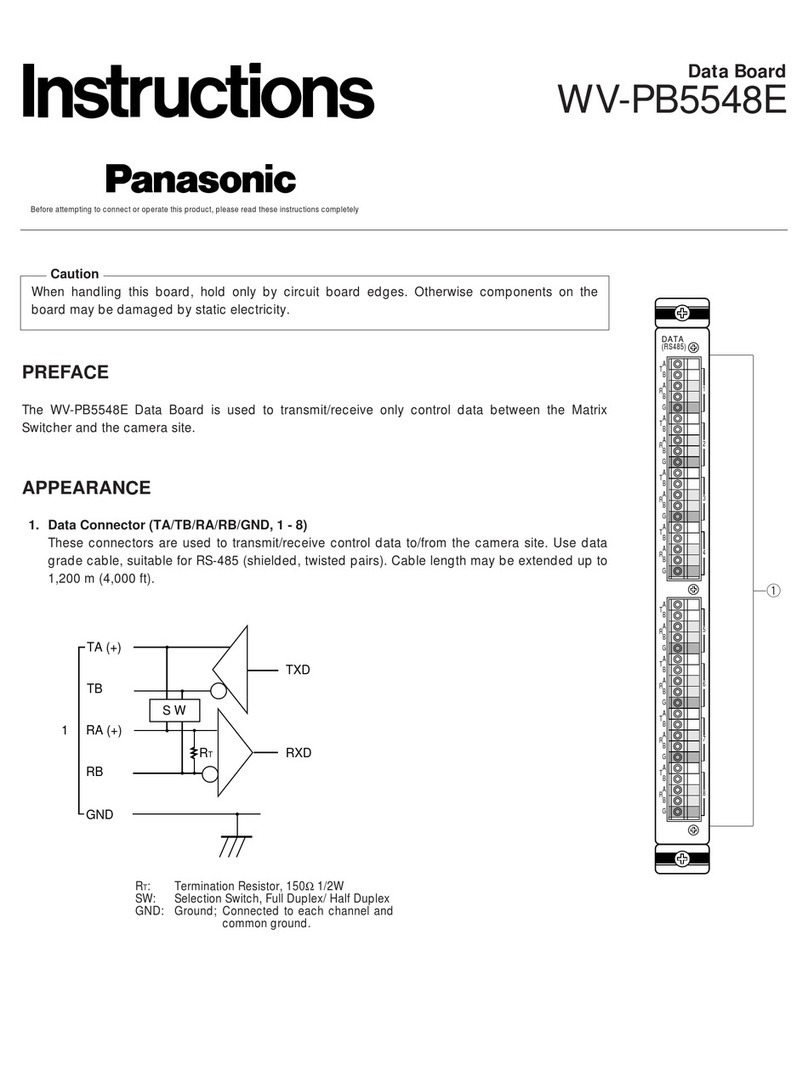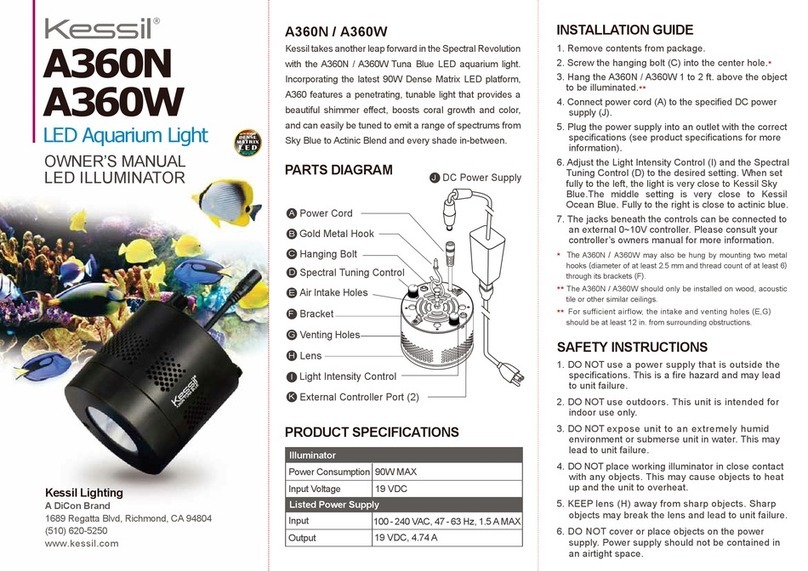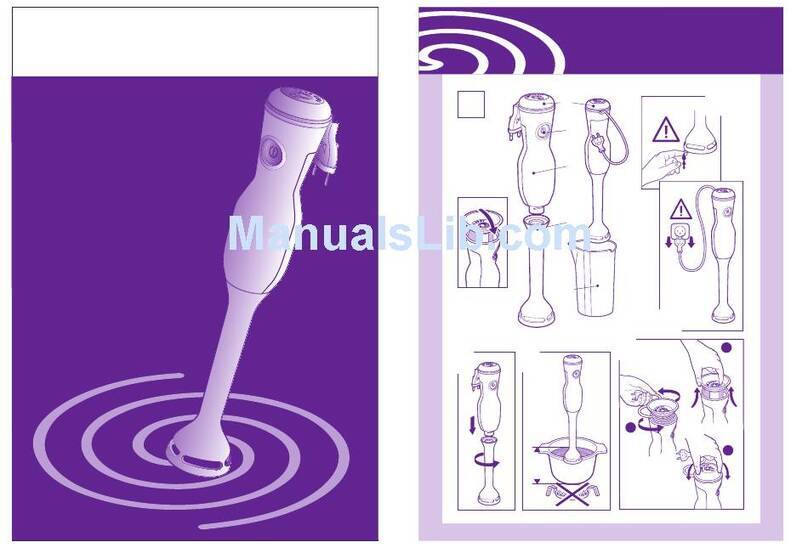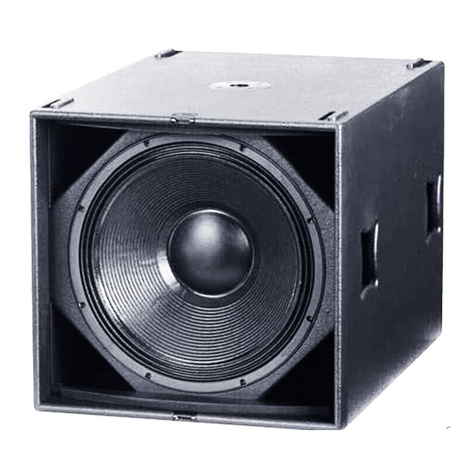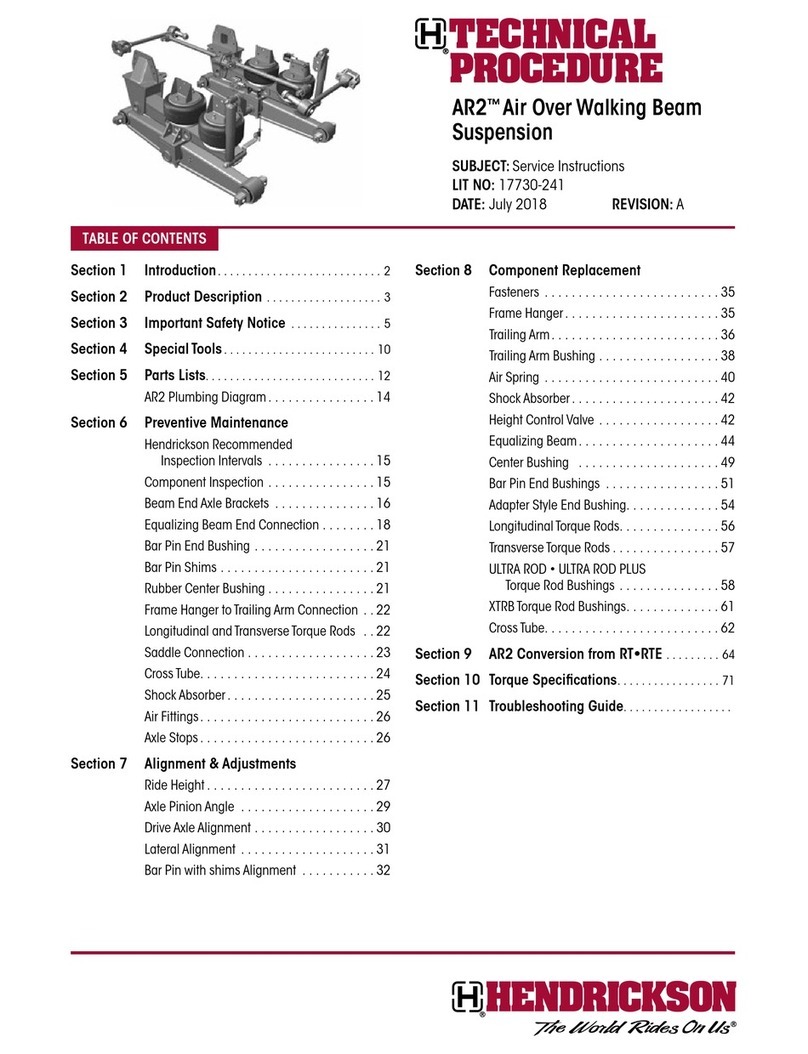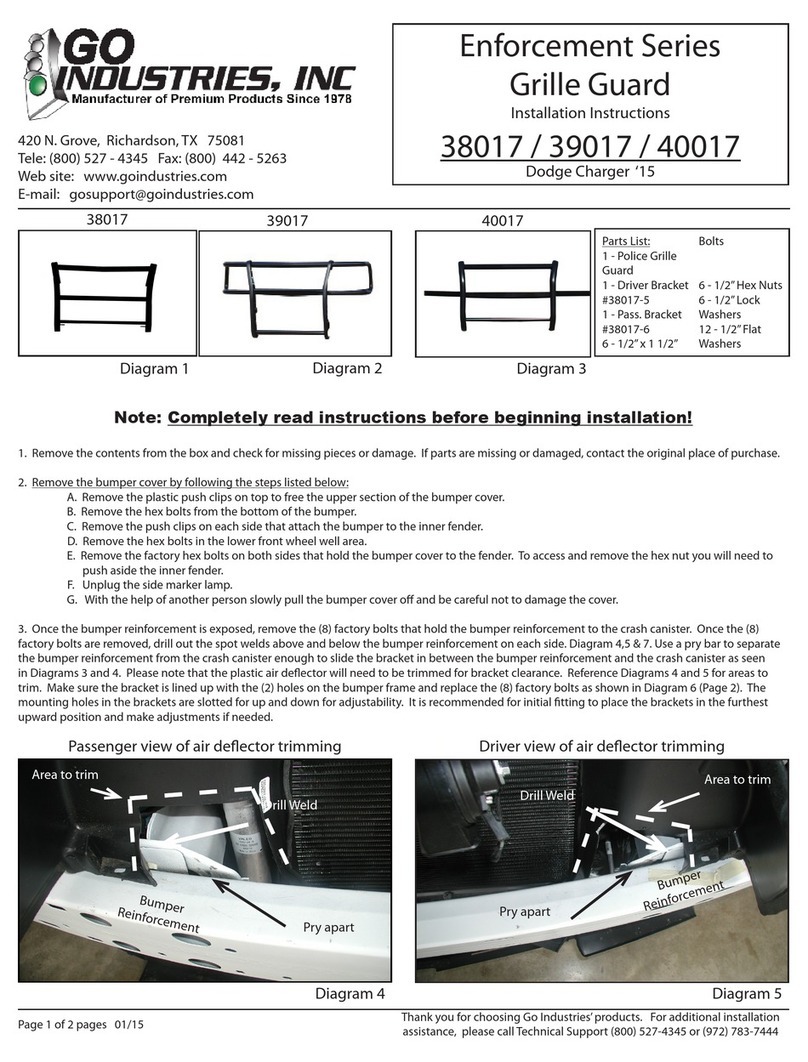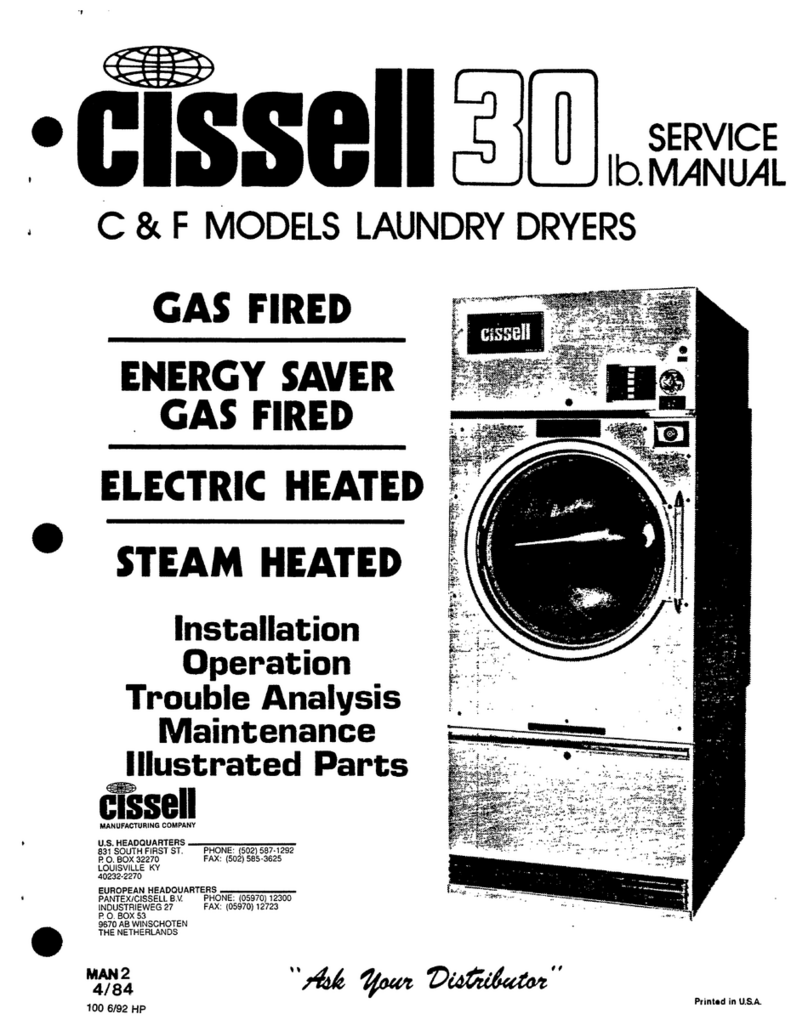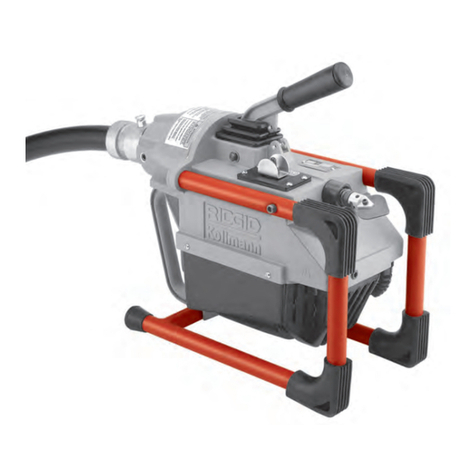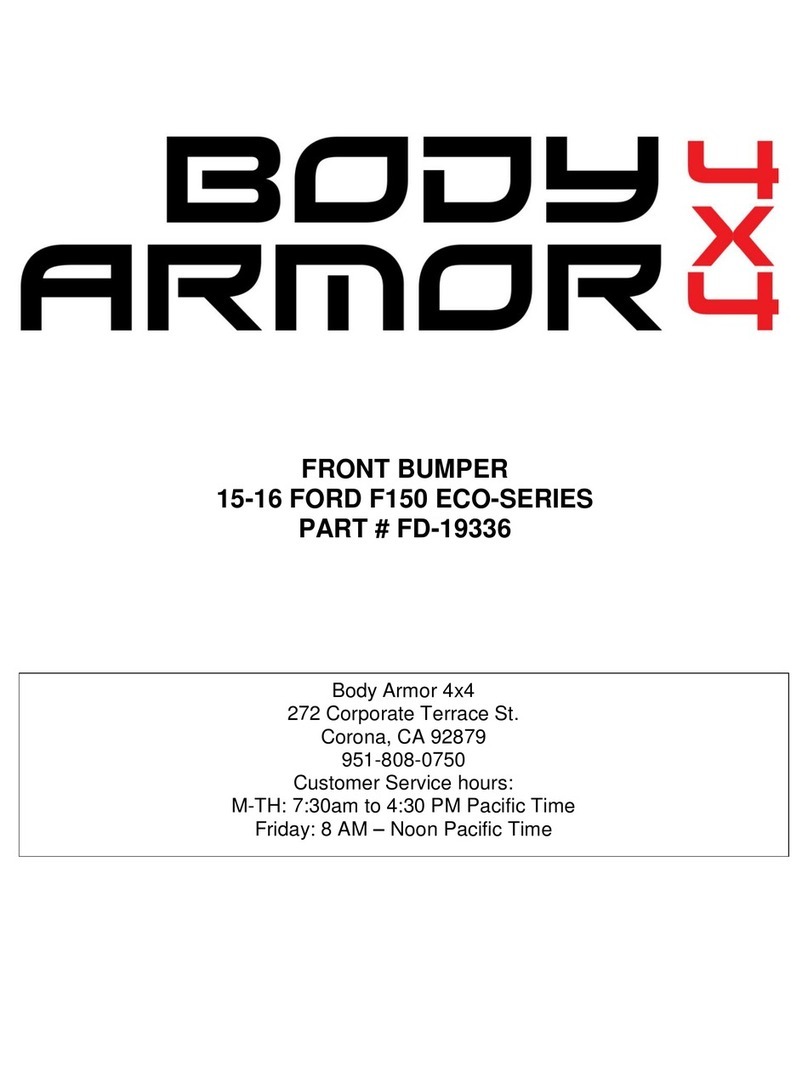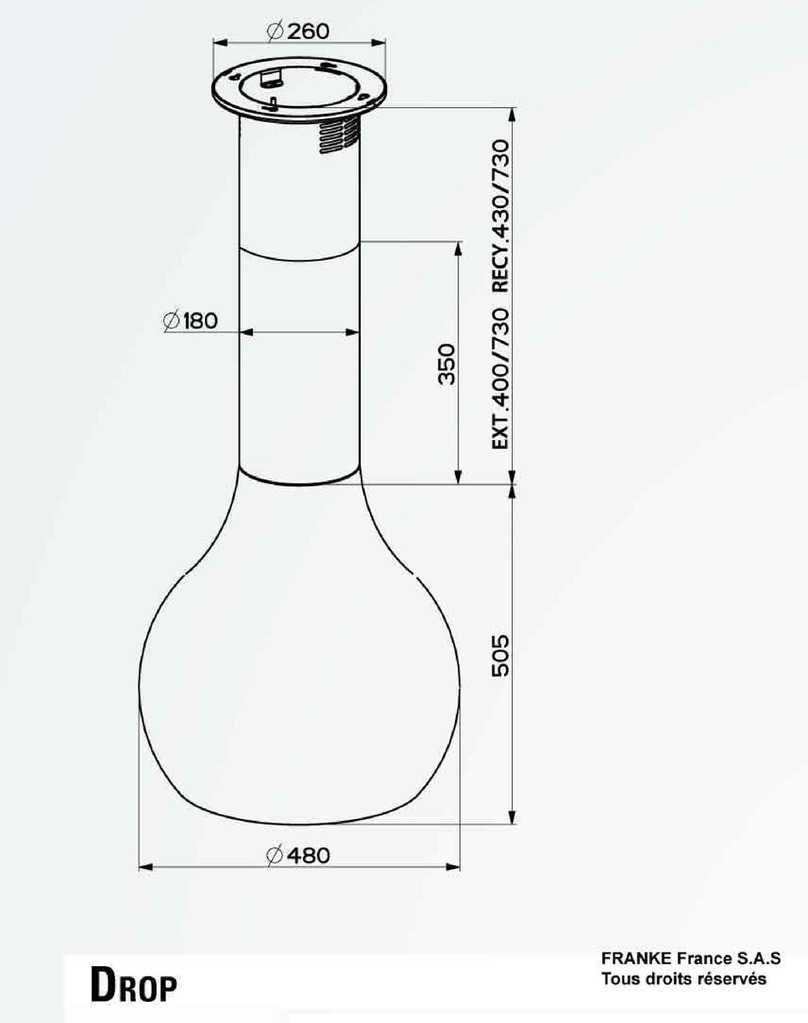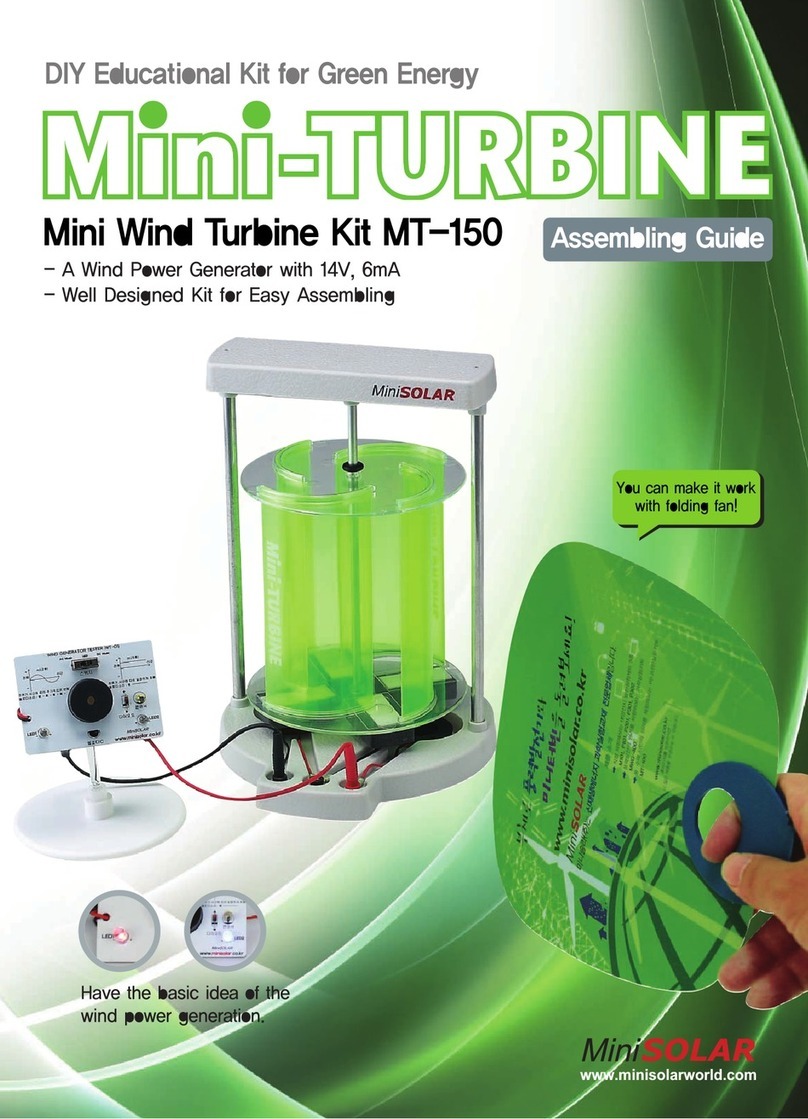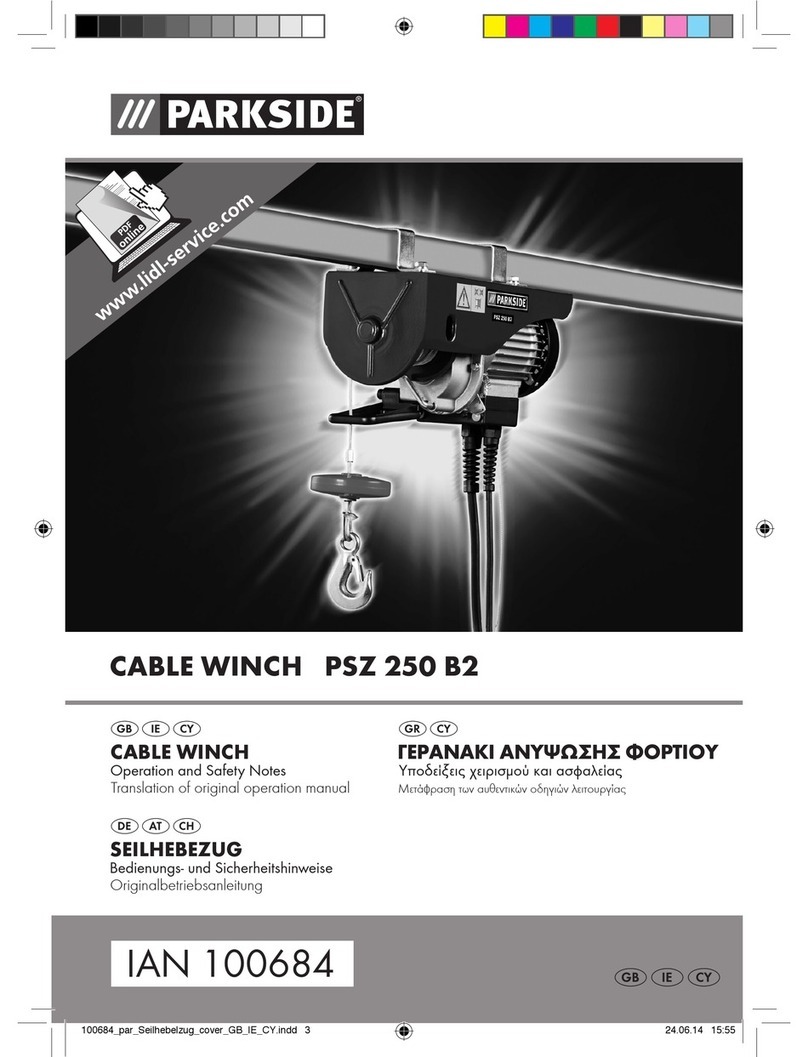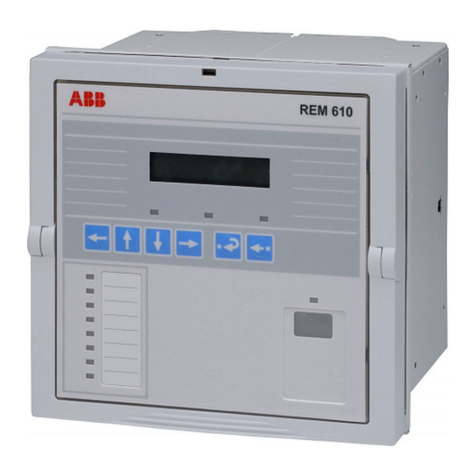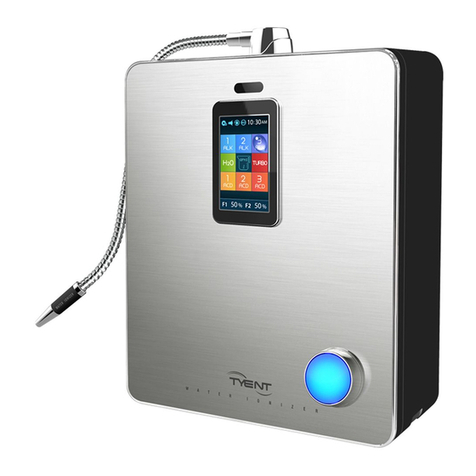
9SPECIFICATIONS
Item Type Fan type ionizer
Model No. ER-Q
Charge removal time 1.5 sec. approx. (Note 1)
Ion balance ±10 V or less (Note 1)
Power supply voltage 24 V DC ±10 %
Power consumption 200 mA or less
Discharge method High-frequency AC method
Discharge output voltage ±2 kV approx.
Max. fan speed 6.4 m/s (Note 1)
Max. fan volume 0.2 m3/min
Output
(CHECK, ALARM)
NPN transistor/open collector
• Max. sink current: 50 mA
•
Applied voltage: 30 V DC or less (between output terminal and 0 V)
• Residual voltage: 1 V or less (at input current of 50 mA)
Output operation
Check: On when discharge check (Note 2) detected
Off at all other times
Error: Off when discharge error or fan error (Note 2) detected
On at all other times
Short-circuit protection Incorporated
Indicators
DSC Green LED (Lights up during normal discharge)
ALARM
Red LED (Lights up during discharge checking and when
discharge error (Note 1) detected, blinks when fan error (Note 1)
detected)
Ozone generation amount 0.02 ppm or less (Note 1)
Pollution level2
Ambient temperature
0 to + 50°C (No dew condensation) / Storage temperature: -10 to + 65°C
Ambient humidity
35 to 65% RH (No dew condensation) / Storage temperature: 35 to 65% RH
Operating altitude 2,000m or less (Note 3)
Vibration resistance 10 to 150 Hz frequency, 0.75 mm amplitude in X, Y and Z
directions for two hours each
Over-voltage category I
Material Enclosure: PBT Discharge needle: Tungsten
Grounding methodC(capacitor) grounding
Weight 110g approx. (main unit only)
Accessories Wiring connector: 1 set
[Manufactured by MOLEX: Housing (5557-08P), Terminal (5556T)]
Notes: 1) Representative value at 100 mm from directly in front of fan outlet, maximum fan speed
with fi lter not installed.
2) Discharge check: Drop in discharging status detected.
Discharge error: Abnormal discharge detected.
Fan error: Fan operating problem detected.
3) Do not use or store the device in an environment where the air pressure is higher than the
atmospheric pressure at an altitude of 0 meters.
10
CAUTIONS
This product has been developed / produced for industrial use only.
Do not use this product for any purpose other than charge removal and dust removal.
Do not use this product in enviroments which are outside the specification range,
otherwise operating problems or damage may occur. In addition, the operating life of the
product may become significantly reduced.
Never disassemble, repair or modify this product, otherwise operating problems or
accidents may occur.
Do not dispose of this product by burning it, otherwise it may explode or toxic fumes may
be generated.
This product generates ozone, so be sure to provide adequate ventilation if using it in a
confined space.
Do not run the wires together with high-voltage lines or power lines or put them in the
same raceway. This can cause malfunction due to induction.
Be sure to turn off the air and the power supply before carrying out any cable connection
or inspection work. If this is not done, operating problems, damage or electric shocks
may occur.
After connecting the cables, check that the connections are correct before turning on
the power. If the cables are connected incorrectly, operating problems or accidents may
occur.
Verify that the supply voltage variation is within the rating.
It takes approximately 2 seconds after the power is turned on before the fan operation
stabilizes. To ensure proper charge removal performance, do not use the product until
sufficient time has elapsed.
Do not turn the power back on immediately after it has been turned off, otherwise operating
problems or accidents may occur. In addition, the operating life of the product may become
signifi cantly reduced. Wait at least 2 seconds before turning the power back on again.
When using as a CSA and UL compliant product, use a CLASS 2 CSA/UL certified
power supply, or a CSA/UL certified power supply that has been evaluated as a Limited
Power Source as specified in CAN/CSA-C22.2NO.60950-1/UL60950-1.
Do not use any cables which have any damage (such as splitting or cracking), otherwise
operating problems or accidents may occur.
Avoid using the product in places where there are high levels of steam or dust in the air
or where it might be directly exposed to water, oil or welding spatter.
Avoid use at an elevation higher than 2000m, and outdoor use.
Do not touch the discharge needle with hard objects such as tools. If the discharge
needle becomes broken, it will not provide sufficient charge removal performance, and
moreover operating problems or accidents may occur.
Avoid using the product while the fi lter is blocked, otherwise accidents or problems with
operation may occur.
Clean and replace the fi lter at periodic intervals.
Always be sure to turn off the power before replacing the fi lter.
Secure the main unit properly when setting up. If the main unit is not correctly secured
or if it is subjected to intermittent vibrations or impacts, accidents or problems with
operation may occur.
Do not place any objects which may obstruct air flow within 20 mm the front of the fan air
intake, otherwise accidents or problems with operation may occur.
Use cables with a cross-section of 0.15 mm2or more and a length of less than
30 m. Furthermore, keep the cables as short as possible to avoid the possibility of interference.
If this product ceases functioning or is no longer required, dispose of it according to
appropriate local waste disposal regulations.
11
CSA/UL compliant product
This product complies with CSA and UL standards, and has been certified by TUV SUD.
●The discharge needles are consumable parts. If the discharging performance is not
restored after the discharge needles have been cleaned, it is recommended that
you replace the whole discharge needle unit (option). It is recommended that you
replace the discharge needle unit after about 10,000 hours of operation.
[Cleaning and replacement procedure for discharge needle unit]
Follow the procedure given below to remove the discharge needle unit from the main unit.
Use a cotton swab or similar moistened in alcohol to clean the discharge needles
and the areas around them.
If the needles are particularly dirty, use a brush (such as a toothbrush) moistened
with alcohol to rub them clean, and then use a cotton swab to wipe them.
A commercially-available ultrasonic cleaner can also be used for cleaning. (Immerse
the discharge needle unit into the cleaning tank to clean them.)
Insert the tabs of the discharge needle unit into the two slots in the main unit, slide
the discharge needle unit sideways to install it to the main unit until a click is heard.
[Discharge needle unit removal procedure]
* Do not touch the interior of the main unit when removing and installing the discharge
needle unit, otherwise accidents or problems with operation may occur.
* Do not apply any more force than is necessary when removing and installing the
discharge needle unit, otherwise the discharge needle unit may become damaged.
[Fan filter cleaning and replacement procedure]
Install and use a fi lter depending on the operating environment.
7OPERATION MATRIX
Indicator
(
O
: Lit, : Off, : Blinking)
Output
Discharge
operation
Fan
operation
Discharge
(DSC)
Alarm
(ALARM) Check Error
Green RedNormal open
Normal closed
Normal OFFONONON
Discharge check
ON ON ON ON
Discharge error
OFFOFF OFF OFF
Fan error OFFOFF OFF OFF
* Once an error has been detected, the error status will be maintained until the power
is turned off and back on again.
* Eliminate the cause of the error before turning the power back on again.
* If the cause of the error has not been eliminated, the error will occur again.
8TROUBLESHOOTING
●Be sure to turn off the power before checking the discharge unit or the fan unit.
Problem Probable cause Remedy
Discharge check
Discharge
Alarm
Dirty discharge
needle
Wear
Condensation
F.G. not
connected
・
Check that the power supply voltage is within theusable
range.
・
Turn off the power and check that the tips of thedischarge
needles are not worn or dirty and that the discharge
needle unit is correctly installed to the main unit.
・
If the alarm indicator remains lit even after the discharge
needles have been cleaned, check for any dirt around
the discharge needles also.
・
Check that the F.G. terminal is securely connected to the round.
Discharge error
Discharge
Alarm
Foreign object
obstruction
Condensation
F.G. not
connected
・
Check that the power supply voltage is within the usable
range.
・
There may be an abnormal discharge. Turn off the
power and check that the discharge needles are not
dirty or broken and that the discharge needle unit is
correctly installed to the main unit.
・
If the alarm indicator remains lit even after the discharge
needles have been cleaned, check for any dirt and
foreign objects around the discharge needles also.
・
Check that the F.G. terminal is securely connected to the ground.
Fan error
Discharge
Alarm
Fan intake
covered
Filter blocked
Foreign object
obstruction
・
Turn off the power and check if the fi lter is blocked.
・
Check if there are any foreign objects inside the product.
* Indicators ( : Lit, : Off, : Blinking)
1 Hook your finger into the slot in the
discharge needle unit and slide the
unit in the direction shown in the
illustration until a click is heard.
2 After this, you can pull the
discharge needle unit toward you
to remove it.
1
2
Turn the filter cover in the direction shown in the illustration to align the * marks.
Remove the filter cover and the filter from the ER-Q main unit.
Remove the filter from the filter cover, and remove any dust and dirt adhering to the filter. If the
filter is extremely dirty, wash it in water. If washing the filter in water, let it dry thoroughly before
using it again.
Install the filter and the filter cover to the ER-Q main unit.
* If the filter is used while it is still wet, accidents or problems with operation may occur.
* If the filter cannot be cleaned, replace it.
* Be careful not to let any foreign objects get inside the main unit when removing and installing the
filter.
http://panasonic.net/id/pidsx/global
Overseas Sales Division (Head Office)
2431-1 Ushiyama-cho, Kasugai-shi, Aichi, 486-0901, Japan
Phone: +81-568-33-7861 FAX: +81-568-33-8591
About our sale network, please visit our website.
PRINTED IN JAPAN©Panasonic Industrial Devices SUNX Co., Ltd. 2016


